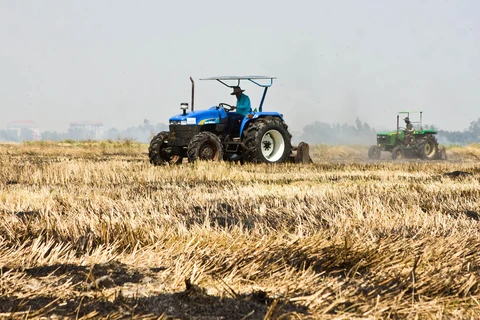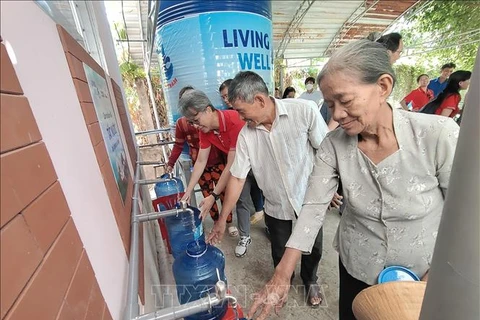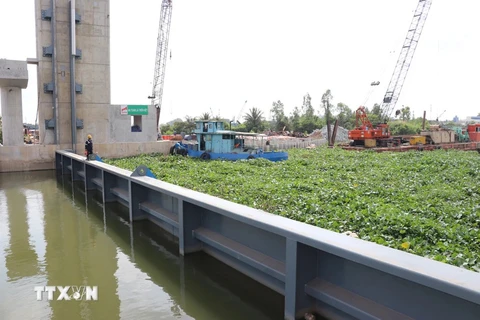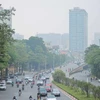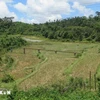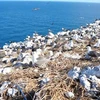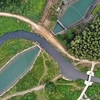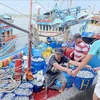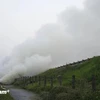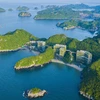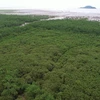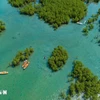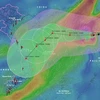
Hanoi (VNS/VNA) - The Mekong Delta is expected to experience unusually high saltwater intrusion during the upcoming dry season, albeit less severe than in 2015-16, 2019-20 and 2023-24.
According to the Ministry of Agriculture and Rural Development’s Irrigation Department, saltwater intrusion will gradually intensify this month.
The delta, the country’s largest producer of rice, fruits and seafood, typically suffers from saltwater encroachment through river mouths during the dry season, which spans from December to April.
In coastal areas, seawater has entered deep into major river mouths. Water with a salinity level of four grams per litre has appeared 15-20 kilometres up most rivers. Most crops can only tolerate water with a salinity level of less than one gram per litre.
However, this is seven to 19 kilometres less than during the same period last year.
Challenges for the delta
The delta faces ongoing challenges, including reduced water flow from upstream sections of the Mekong River, rising sea levels, saltwater intrusion, and erosion.
These issues complicate the supply of water for both household consumption and agricultural activities.
Water levels in the Mekong River at Kratie in Cambodia and Tan Chau and Chau Doc stations in the delta decreased last month, the Irrigation Department reported. During the 2023-24 dry season, around 73,900 households experienced water shortages, and over 1,189 hectares of rice were damaged due to insufficient irrigation.
The delta, home to 18 million people – 77% of whom work in agriculture – relies on 15 large irrigation systems that serve over 2.5 million hectares of farmland, accounting for 64% of its total agricultural land. It also utilises approximately 43,000 natural water reservoirs for storage.
Efforts to mitigate impacts
The effective operation of the delta’s irrigation systems in recent years has reduced the impact of saltwater intrusion and drought, according to experts.
Tran Duy Anh, deputy head of the Southern Institute of Water Resources Research, said that with comprehensive measures the delta aims to supply up to 90% of its irrigation water needs for agriculture by 2025.
The long-term goal is to develop a sustainable agricultural region that adapts to climate change and harmonises with nature.
These measures include construction and non-construction projects, such as developing modern water supply systems for aquaculture and implementing separate water supply and drainage systems in areas favourable for aquaculture.
Plans are also in place to build five water plants with a combined capacity of 1.5 million cubic metres per day to process water from the Mekong River for household and agricultural use.
Additionally, the region will complete construction projects to manage saltwater intrusion and enhance the storage and supply of freshwater.
Localities' preparations
Provinces in the delta, including Tra Vinh, are taking proactive steps to prepare for the 2024-25 dry season.
Tra Vinh, one of the provinces hardest hit by saltwater intrusion, has instructed districts to implement measures to prevent saltwater intrusion and store freshwater for agricultural use.
The province has made progress in upgrading its irrigation infrastructure, having dug 412 new irrigation canals, dredged over 321 kilometres of existing canals, and repaired 12 embankments spanning 5.6 kilometres.
Addressing erosion
The delta also faces significant erosion challenges, with 686 sites of river erosion spanning 591 kilometres and 57 sites of coastal erosion covering 233 kilometres, according to the Southern Institute of Water Resources Research.
Ca Mau province, which has the second longest coastline in Vietnam at 254 kilometres, is particularly affected.
The province has 188 kilometres of coastline classified as severely or extremely eroded.
Efforts have been made to address 78 kilometres of these sites, but further action is urgently needed.
Nguyen Thanh Tung, head of the Ca Mau Irrigation Sub-department, called for government support to research and approve a project to protect the province’s sea dykes.
Provinces like Bac Lieu are also grappling with high acquisition clearance costs for erosion prevention works.
Pham Thanh Hai, deputy head of Bac Lieu province’s Irrigation Sub-department, urged the Southern Institute of Water Resources Research to develop solutions that minimise disruptions to local residents.
Efforts to build embankments and grow mangrove forests along the coast continue to play a crucial role in mitigating erosion across the delta./.
